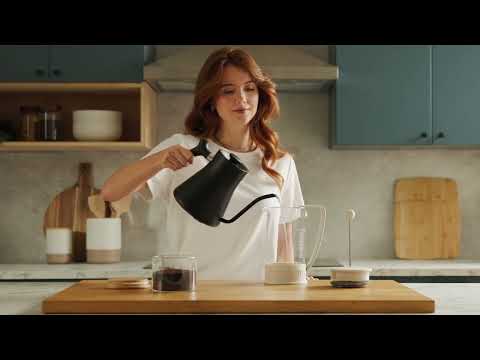Reverse osmosis isn’t just another filter upgrade — it’s the one method we’ve actually proven in the lab to strip out the broadest mix of contaminants. In Tap Score testing, our top systems wiped out PFAS, chloroform, nitrates, salts, and even microplastics that most filters miss.
But not every RO is worth it. Some are fast and efficient, others are clunky, high-waste, and expensive to maintain. We’ve spent years living with them, swapping filters, and validating results so you don’t have to guess which ones actually deliver.
📌 Expert Picks
Skip the guesswork — choose the system that matches your home, water quality, and usage needs:
- 🏆 Best Overall Tankless: Waterdrop G3P800 — High-flow, compact, NSF-certified
- 🏠 Best for Renters: AquaTru Classic — Countertop, no plumbing, NSF-certified
- 📲 Best Smart Choice: Cloud RO — App-connected, tankless, steady flow
- 💵 Best Budget Traditional: APEC ROES-50 — Reliable, NSF 58, tank-based
- 💧 Best Multifunction RO: Waterdrop A1 – Hot & Cold Countertop RO
Let’s get started…
#1. WaterDrop G3P800

Scoring basis
- Filtration Performance (45%): THMs completely removed
- salts reduced ~85%
- multi-stage RO + carbon polish
- Flow / Pressure (20%): Tankless 800 GPD, sustained high-flow at sink
- Install & Maintenance (10%): Quick-change cartridges, compact under-sink footprint
- Build Quality (10%): Solid construction, integrated monitoring, clean design
- Taste & Odor (5%), Operating Cost (5%), Certifications & Transparency (5%)
The Waterdrop G3P800 has been under our sink for 3+ years, and it’s still the fastest RO we’ve tested.
Our Tap Score showed a jump from 77 → 96, with 100% of THMs removed and sodium/chloride cut by ~80–85%.
Why We Like It:
- Lab-tested clean after 3+ years — still no drop in performance.
- Smart faucet tracks TDS + filter life so you never guess.
- Built-in UV adds extra peace of mind against microbes.
- Tankless speed and a low hum make it easy to live with.
What Could Be Better
- No remineralization filter included — it’s a ~$30 add-on, wish they bundled it
- Faucet only comes in one finish (ours is brushed nickel)
Use Coupon code QWL-10OOF
Best for: Families of up to 6 who want fast, NSF-certified RO water with a 3:1 wastewater ratio and no bulky tank.
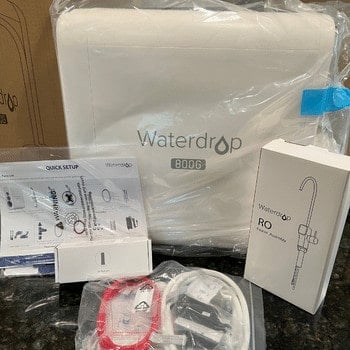
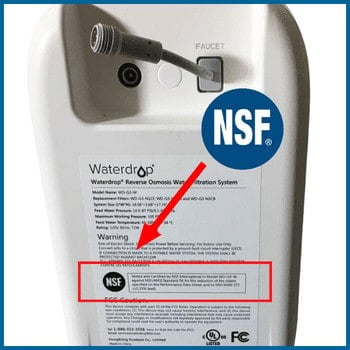
🔬 Lab-Tested Results
Independent Tap Score tests compared our city water before install (June 2022) and after 3+ years on the G3P800 (August 2025).
These results weren’t pulled from a spec sheet — they came from Tap Score’s independent lab, verifying the G3P800 removes regulated contaminants and lowers salts/metals in a way we could actually measure at the faucet.
PFAS and microplastics results are covered on their own pages for clarity.
Pre-G3P800 Install

Post-G3P800 Install
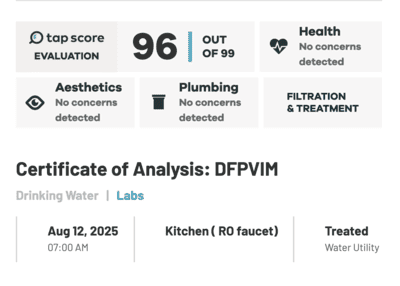
🔬 Tap Score Lab Results — Waterdrop G3P800
| Parameter | Before | After | Change |
|---|---|---|---|
| Total THMs iEPA MCL: 80 ppb | 31.83 ppb | NDRemoved | −100% |
| Chloroform (THM) | 21.57 ppb | NDRemoved | −100% |
| Bromodichloromethane | 7.93 ppb | NDRemoved | −100% |
| Dibromochloromethane | 2.33 ppb | NDRemoved | −100% |
| Sodium | 46.3 ppm | 10 ppm | −79% |
| Chloride | 67.26 ppm | 11 ppm | −84% |
| Barium iEPA MCL: 2 ppm | 0.01 ppm | 0.003 ppm | −75% |
| Total Dissolved Solids (TDS) | 187 ppm | 28 ppm | −85% |
Context & Methods
“ND” = Not Detected above the lab reporting limit. THMs compared to EPA MCL (80 ppb). Barium compared to EPA MCL (2 ppm). Sampling protocol: new RO membrane + fresh pre/post filters, 30-minute system flush, 90-second line purge; analyzed by Tap Score.
Pre-test (before installing G3P800):
View baseline report (PDF)
Post-test (after 3+ years of use on G3P800):
View post-install report (PDF)
View official Tap Score report
🛠 Maintenance & Costs
- 🔄 Filter swaps: <60 seconds — twist/turn, no tools.
- ⚠️ Alerts: Yellow = caution (soft beep), red = constant alarm until replaced.
- 💰 Annual cost: ~$172 ($0.16–$0.23/gal depending on usage & deals).
- 🚰 Vs bottled water: At $1–$3/gal, even one person spends $365–$1,095/yr on bottled. The G3P800 averages just ~$172/yr in filters. Families save hundreds to thousands, while cutting plastic waste.
- 🧪 Taste & pH: Like all RO systems, minerals are stripped. Our Tap Score showed TDS dropped ~85%, leaving water clean-tasting but “flatter” unless you add a remineralization stage.
📝 User Notes
- ⚡ Outlet Quirk: If your RO shares an outlet with a garbage disposal, you’ll need to unplug the disposal when running the system and plug it back in afterward. Not a dealbreaker, but worth planning.
- 🛠 Setup Effort: Installing the drain line and outlet took more effort than a countertop system — call it a 7/10 difficulty. Once in, maintenance is simple.
- 🔔 Filter Alerts: Yellow means swap soon (gentle beep). Red is aggressive and won’t stop until you replace the filter.
- 💧 TDS Creep: First pour runs 10–15 ppm, then stabilizes near 10 after a 5–10s flush. As filters age, TDS can climb into the 25+ range until swapped.
- 🌱 Flush Wastewater: Each new filter requires a flush cycle — CF ~5 min, CB ~15 min, RO ~30 min. It feels wasteful, but we reuse the water for plants.
- 🔄 Auto-Flushing: The system also performs ~20-second automatic flushes to keep the RO membrane clean. Quiet, background maintenance that extends filter life.
📝 Final Take
The Waterdrop G3P800 isn’t just another tankless RO — it’s one of the few we’ve run long enough to prove its consistency. Lab data showed THMs eliminated and salts controlled, but it’s the ownership quirks that set it apart: foolproof filter alerts, predictable TDS creep, and a flush routine that becomes second nature.
Yes, the outlet hassle and long flush cycles are trade-offs, but they’re small compared to what you get: lab-grade water, family-ready flow, and half your cabinet space freed up. Compared to countertop units like AquaTru, the G3P800 runs circles around them in speed. Cloud RO comes closer in design but falls short on efficiency and certifications.
That’s why it still holds our #1 spot with a confident 5/5 rating.
Use Coupon code QWL-10OOF
Read the full review: Waterdrop G3P800
#2. AquaTru Classic
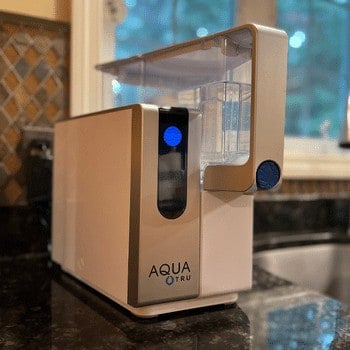
Scoring basis
- Filtration (RO) (45%): 4-stage RO: sediment + carbon + RO membrane + polishing. Tap Score verified PFAS and microplastics reduced to non-detect
- advanced city panel still in progress.
- Flow/Pressure (20%): Steady countertop RO delivery
- no plumbing required
- 3-quart reservoir suits daily cooking and drinking needs.
- Install/Maint (10%): Plug-and-play setup
- filter swaps in minutes
- annual operating cost about $100.
- Build (10%): Solid countertop unit
- NSF-certified parts
- BPA/BPS-free Tritan reservoirs.
- Taste (5%), Cost (5%), Certs (5%)
The AquaTru Classic has been in my setup twice now — first in my own kitchen before upgrading to Waterdrop, and later in my family’s office where it still runs daily.
Our Tap Score confirmed its PFAS reduction, showing it’s more than just countertop convenience.
Just plug it in, fill the tank, and you’ve got clean water on demand — a hassle-free fit for renters, offices, or anyone who doesn’t want to mess with plumbing.
What We Like
- Renter & office friendly — no drilling, no plumbing, just plug in and fill the tank
- Lab-backed — PFAS came back ND in Tap Score testing
- 4:1 efficiency ratio — wastes far less water than most tankless units
- Filters last 6–24 months and replacements are cheaper than under-sink RO
What Could Be Better
- Counter space hog — needs its spot on the counter, unlike under-sink models
- Flow isn’t instant — takes ~15 minutes to fill a full tank
- Tank refill routine — not truly set-and-forget like a plumbed-in system
Best For: Renters, small kitchens, or offices that want certified RO water without a permanent install.
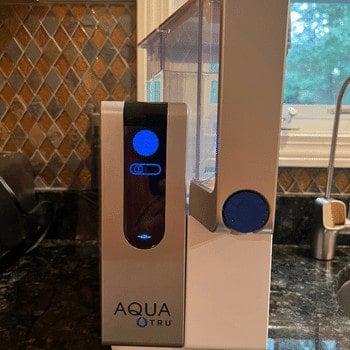
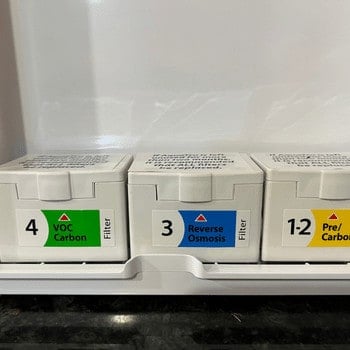
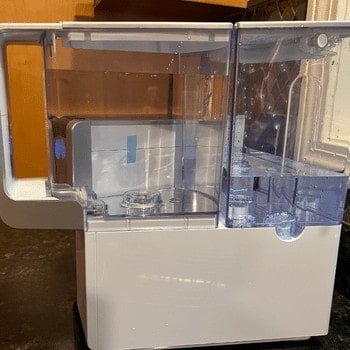
🛠 Maintenance & Costs
- 🔄 Filter swaps: 3 cartridges (6–24 month lifespans); swap is quick but requires a reset button hold.
- 🚰 Flushing routine: Every filter change needs 2 full tank cycles (~25–30 minutes). Hands-on but simple.
- 💰 Annual cost: ~$100–$120, averaging $0.20–$0.25 per gallon. For comparison, a single person relying on bottled water spends $365–$1,095 per year — several times higher, with far more plastic waste.
- ⚠️ Descaling: In hard water areas, expect to descale every 6–12 months. Skipping this can slow performance and may void the warranty. AquaTru sells a kit with citric acid + reusable filters for the process.
📝 User Notes
- 💧 Wastewater tank: Must be emptied after each run; forget once and the system won’t cycle.
- 🕒 Filtration speed: One clean tank takes ~15 minutes. Gravity dispensing slows as the tank empties.
- 🔔 Noise & quirks: The pump runs with a soft hum that can get louder over time. Some users mention a dripping spout and an awkward dispense button placement.
- 🌤 Placement tip: Keep it out of direct sunlight to prevent algae growth in the clear tanks.
- 🧪 Taste/minerals: RO removes nearly all dissolved minerals; water can taste “flat” unless you add the optional alkaline filter or mineral drops.
📝 Final Take
The AquaTru Classic isn’t built for speed — it’s built for simplicity and proven filtration. Between NSF/ANSI certifications and independent PFAS test results, it consistently punches above its countertop category. Yes, the tank refills and occasional descaling are chores, but for renters, small offices, or anyone who wants lab-grade water without plumbing, it’s a smart plug-and-play pick.
Read full review: Aquatru Review
#3. Cloud RO
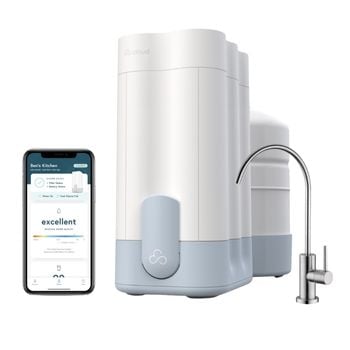
Scoring basis
- Filtration (RO) (40%): 4-stage RO with sediment, carbon, RO membrane, and remineralization. Certified for TDS reduction
- raises pH slightly with mineral boost.
- Flow/Pressure (20%): 2.8-gallon pressurized tank with built-in pump. Decent faucet flow, though slower than sink tap. Rated ~1:1 efficiency ratio.
- Install/Maint (15%): DIY-friendly but still requires faucet hole and drain hookup. Filters bundled in proprietary annual kit (~$200)
- battery replaced yearly.
- Build (10%): Compact under-sink footprint, stainless tank + BPA-free plastics. Solid design but locked into proprietary parts and filter packs.
- Taste (5%), Cost (5%), App/Data (5%)
The Cloud RO is a battery-powered, app-connected reverse osmosis system with a compact 2.8-gallon tank. It’s NSF 58 certified, rated for a 1:1 pure-to-waste ratio, and designed for easy DIY setup.
At $600–$750 with ~$200 annual filter packs, it’s pricier than standard RO units, but appeals to those who want smart tracking and modern design.
Why We Like It
- Sleek, compact design with app-based tracking.
- 1:1 waste ratio beats most traditional RO tanks.
- Faster faucet flow thanks to built-in pump.
- Simple filter swaps (6–24 months).
What Could Be Better
- Filter packs are pricey + only sold as sets.
- Annual battery replacement adds extra cost.
- App limited to Bluetooth range, not true remote.
- Small 2.8-gal tank may not suit big families.
Best For: Homeowners who want modern app tracking and a sleek, tankless RO system without needing a wall outlet nearby.
🔬 Tap Score Lab Results — Cloud RO
| Parameter | Before | After | Change |
|---|---|---|---|
| Total THMs iEPA MCL: 80 ppb | 31.83 ppb | NDRemoved | −100% |
| Chloroform (THM) | 21.57 ppb | NDRemoved | −100% |
| Bromodichloromethane | 7.93 ppb | NDRemoved | −100% |
| Dibromochloromethane | 2.33 ppb | NDRemoved | −100% |
| Sodium | 46.30 ppm | 4.32 ppm | −91% |
| Chloride | 67.26 ppm | 10.70 ppm | −84% |
| Barium iEPA MCL: 2 ppm | 0.010 ppm | 0.0018 ppm | −82% |
| Total Dissolved Solids (TDS) | 187.2 ppm | 66.2 ppm | −65% |
Context & Methods
“ND” = Not Detected above the lab reporting limit. THMs compared to EPA MCL (80 ppb). Barium compared to EPA MCL (2 ppm). Sampling protocol: 2.5-gallon storage tank was flushed three complete times (~7.5 gallons). To ensure no residuals, we doubled that volume and processed ~17 gallons total (including wastewater) before collection. After the final flush, the faucet line was purged for 90 seconds prior to sampling; analysis performed by Tap Score.
Pre-test baseline:
View baseline report (PDF)
Post-test (Cloud RO):
View post-install report (PDF)
View official Tap Score report
🔧 Maintenance & Cost
- 🔄 Pre-filters – Expect to swap the first two (sediment + carbon) about once a year.
- 🧬 RO membrane + battery – Both usually stretch closer to 18–24 months before they need attention.
- 📦 Replacement packs – Everything comes bundled in a single kit (~$200 with filters + battery). No cherry-picking individual pieces, which is convenient but pricey.
- 💰 Ongoing cost – Works out to roughly $180–$200 per year. The app helps track usage and filter life in real time, so you’re not stuck guessing or over-replacing.
📊 Performance Snapshot
- Certified under NSF/ANSI 58 for TDS reduction.
- Third-party data shows strong contaminant reduction across lead, fluoride, PFAS, and chlorine byproducts.
- The mineral stage nudges pH upward (often near 9), which softens the ‘flat’ RO taste and gives the water a smoother finish.
📝 User Notes (Cloud RO)
- First week quirks – Water may look cloudy or “milky” from trapped air; you’ll also hear faint gurgles and see some carbon dust during flushes. It clears up within days.
- Tank reality – The 2.8-gallon reservoir provides decent flow, but once drained, it takes close to an hour to fully refill. Bigger households may notice the limit.
- Efficiency trade-off – Its ~1:1 waste ratio is better than older tank systems (1:3) but less efficient than newer designs like Waterdrop G3P800 (3:1) or AquaTru (4:1).
- Bluetooth-only app – Filter data and alerts only sync when your phone is nearby. It’s simple, but not a true “cloud” connection.
- pH swings – The remineralization cartridge can drive higher pH at first; taste usually balances after a few weeks.
📑 Final Take
Cloud RO sits between categories — more polished and app-friendly than old tank setups, but not as efficient as today’s best tankless units. It has real credibility thanks to NSF 58 certification, solid third-party results, and a built-in remineralization stage that improves taste.
That said, the locked-in filter packs, Bluetooth-only monitoring, and small tank keep it from leading the field.
If you want an under-sink RO with modern tracking and no outlet requirement, it’s worth a look. But if efficiency and long-term costs are the main concern, the Waterdrop G3P800 (3:1) or AquaTru (4:1) are stronger plays. might be the smarter long-term play.
#4. APEC ROES-50

Scoring basis
- Filtration (RO) (40%): Classic 5-stage design: sediment, dual carbon blocks, RO membrane, and post-carbon polish. WQA Gold Seal to NSF/ANSI 58 for TDS reduction.
- Flow/Pressure (20%): 4-gallon pressurized tank delivers steady output but slows as it fills. 4:1–5:1 pure-to-waste ratio is far less efficient than tankless systems.
- Install/Maint (15%): Straightforward DIY install
- uses spanner wrench for filter swaps. Pre-filters replaced 6–12 months
- RO membrane 2–4 years. ~$80–$100 per year upkeep.
- Build (10%): Proven, long-market design. Uses standard 10” non-proprietary filters—cheap, widely available, and OEM compatible.
- Taste (5%), Cost (5%), Reliability (5%)
The APEC ROES-50 is a no-frills, 5-stage under-sink system that’s been a kitchen staple for years. It’s slower and less efficient than today’s tankless designs, but at under $250 upfront and about $80 a year in filters, it remains one of the most affordable ways to get clean, reliable RO water.
What We Like
- Proven 5-stage design that reliably improves taste and clarity
- Filters are inexpensive compared to most RO systems (~$80/year)
- Long-lasting RO membrane (2–4 years between swaps)
- Still one of the most trusted budget under-sink units after years on the market
What Could Be Better
- Filter changes require the included spanner wrench — not as quick as twist-and-lock designs
- Wastes 4–5 gallons for every gallon of purified water (less efficient than tankless systems)
- Bulky storage tank takes up a lot of cabinet space
- No reminders — you have to track filter life manually
Best For: Homeowners who want a low-cost, time-tested RO system and don’t mind the space and higher wastewater trade-off.
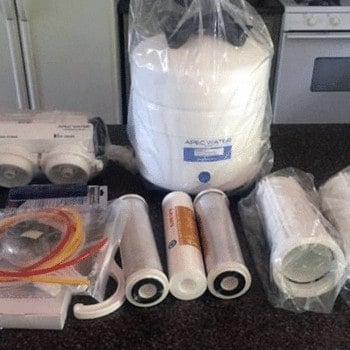
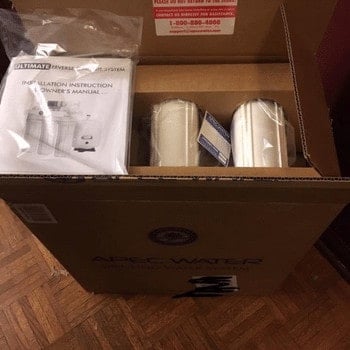
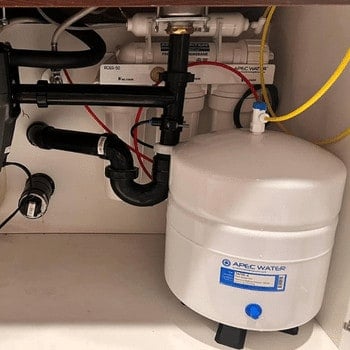
🔧 Maintenance & Cost
- 💰 Annual cost – Runs about $80–$100 a year, making it one of the cheapest long-term RO systems to maintain. Standard 10″ filters are widely available, so you’re not stuck buying proprietary parts.dern RO systems, thanks to widely available standard 10” filters. The trade-off is more hands-on maintenance compared to quick-change cartridges.
- 🔄 Pre-filters (sediment + 2 carbon) – These do the heavy lifting upfront and usually need swapping every 6–12 months, depending on your water.
- 🧬 RO membrane + post-carbon – Built to last. Most owners get 2–4 years before replacing.
- 🔧 Tools required – Uses the included spanner wrench to crack open housings. Not as quick as twist-and-lock, but it seals tight and reliable.
📝 User Notes
- 🔧 Wrench required – filter housings tighten under pressure, so you’ll use the included spanner each change. It’s not tool-free like modern cartridges, but reliable once resealed.
- 💧 High waste ratio – expect 4–5 gallons down the drain for every gallon filtered. Less efficient than pump-driven or tankless units.
- 📉 Flow quirks – faucet pressure is decent when the 4-gallon tank is full but slows to a trickle as it empties. Recovery takes hours, so big families may notice lag.
- 🗂 No smart tracking – you have to monitor usage yourself; most owners go by taste, TDS meter, or a calendar reminder.
- 📦 Takes space – the tank plus three housings can crowd a smaller under-sink cabinet, especially if you’ve got a disposal installed.
- 🕒 Proven longevity – the upside is durability. Many owners run these for 5–10 years with nothing more than regular filter swaps.
📑 Final Take
The APEC ROES-50 isn’t flashy, but that’s the appeal. It’s a classic 5-stage RO that delivers clean, neutral-tasting water without apps, batteries, or gimmicks. Yes, the 4–5:1 waste ratio and bulky tank feel dated next to modern tankless designs, and filter swaps take a wrench. But at under $250 upfront and ~$80 a year in filters, it’s one of the most affordable long-term ways to get RO water — and its track record for reliability keeps it a go-to budget pick.
#5. Waterdrop A1 Hot & Cold RO System
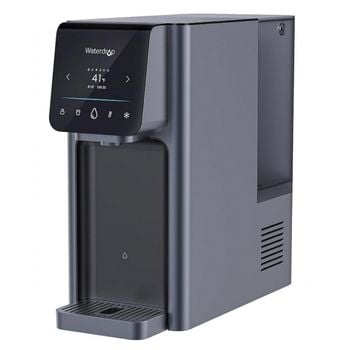
Scoring basis
- Filtration (RO) (40%): 6-stage RO + carbon. Advanced City lab test pending.
- Flow/Pressure (20%): Batch production
- instant dispense once tanks ready.
- Install/Maint (15%): Plug-and-play, tool-free swaps. CF $39.99, RO $59.99. Full flush ~11 min when replacing both filters.
- Build (10%): Appliance-style design with heater/chiller. Compact footprint.
- Taste (5%), Cost (5%), Reliability (5%)
Tap Score results are pending, but early testing confirms chlorine reduction. Unlike AquaTru or G3P800, the A1 dispenses hot and cold water on demand — a unique perk, though pricier at $509 with longer flush cycles. I first reviewed it two years ago and passed it on to family; now I’m retesting with lab data.
What we like
- Unique hot & cold dispense — no other countertop RO offers it
- Compact, sleek design for small kitchens
- 2:1 waste ratio is better than most tank systems
- Straightforward filter swaps (CF ~6 mo, RO ~12 mo)
What we don’t like
- Higher upfront cost ($509) than peers
- Flush cycles take ~11 minutes when changing both filters
- Only NSF/ANSI 372 certified — broader certifications would add trust
Use Coupon code QWL-10OOF

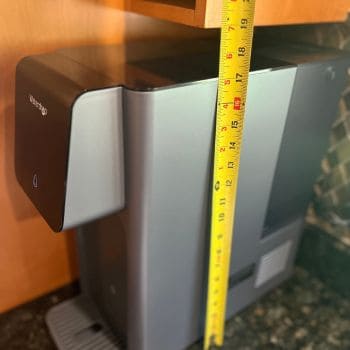
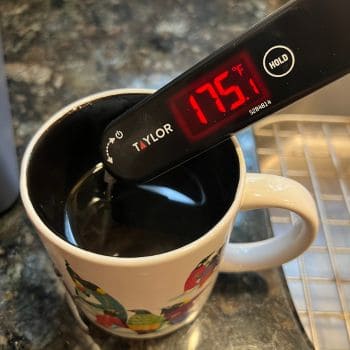
🔬 Tap Score Lab Results — Waterdrop A1 Countertop RO
| Parameter | Before | After | Change |
|---|---|---|---|
| Total THMs iEPA MCL: 80 ppb | 31.8 ppb | NDRemoved | −100% |
| Chloroform (THM) | 21.6 ppb | NDRemoved | −100% |
| Bromodichloromethane | 7.9 ppb | NDRemoved | −100% |
| Dibromochloromethane | 2.3 ppb | NDRemoved | −100% |
| Sodium | 46.3 ppm | 8.6 ppm | −81% |
| Chloride | 67.3 ppm | 8.5 ppm | −87% |
| Barium iEPA MCL: 2 ppm | 0.010 ppm | 0.002 ppm | −80% |
| Total Dissolved Solids (TDS) | 187 ppm | 26 ppm | −86% |
Context & Methods
“ND” = Not Detected above the lab reporting limit. THMs compared to EPA MCL (80 ppb). Barium compared to EPA MCL (2 ppm). Sampling protocol: new RO membrane + fresh pre/post filters, 3× full tank flush, 90-second purge; countertop A1 in standard kitchen use; analyzed by Tap Score.
Pre-test (baseline city water):
View baseline report (PDF)
Post-test (Waterdrop A1 countertop RO):
View post-test report (PDF)
Official Tap Score report:
View official report
Tap Score: 84/99 overall performance rating
📌 Note: Earlier third-party testing of the Waterdrop A1 raised concerns about potential dichloromethane leaching. In this independent QWL Tap Score analysis, dichloromethane was not detected (ND). This suggests the issue has been resolved in the latest production units.
🧾 How It Scored
Our chlorine strip test showed zero residual chlorine out of the gate — an early pass while we wait on full Tap Score results.
Daily use is where the A1 really flexes. The smart OLED panel tracks TDS in real time, lets you pick cup sizes, and shows water temps at a glance. Both hot and cold tanks use dual UV sterilization (rated 99.9%), giving some peace of mind against bacterial growth between cycles.
In my testing, hot water hit 175°F — enough for tea or instant meals without waiting on a kettle. That makes the A1 more than a filter; it’s an all-in-one drinking water station.
Maintenance is manageable: dual filter flush cycles take ~11 minutes after swaps, with annual upkeep around $100 (CF: $39.99, RO: $59.99). I only lived with the unit for a week before handing it off, but two years later it’s still running reliably in a family kitchen — no breakdowns, no hiccups.
👉 Bottom line: While full lab verification is pending, the A1 already proves itself as a multifunction RO that blends strong filtration with everyday convenience features you won’t find on other systems.
Read full review: Waterdrop A1
🧭 Buyer’s Guide
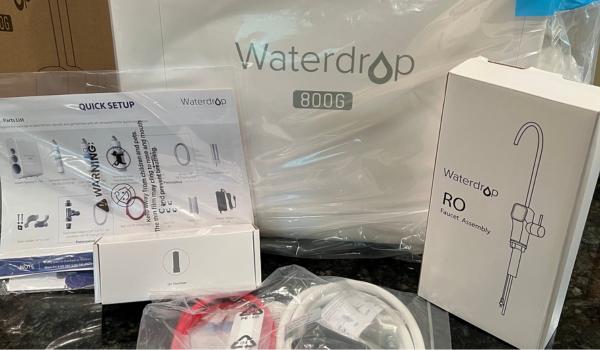
Reverse osmosis (RO) isn’t hype — it’s the one filtration method proven to strip out the broadest mix of contaminants: PFAS, disinfection byproducts, nitrates, salts, heavy metals, and even microplastics.
What sets this guide apart is that we’re not just comparing spec sheets. Each system here has been vetted with a mix of Tap Score lab testing, NSF/IAPMO certification checks, and long-term installs. That means you’re not just seeing what the manufacturer claims — you’re seeing what these systems actually delivered in real-world kitchens.
🔬 How We Test & Score
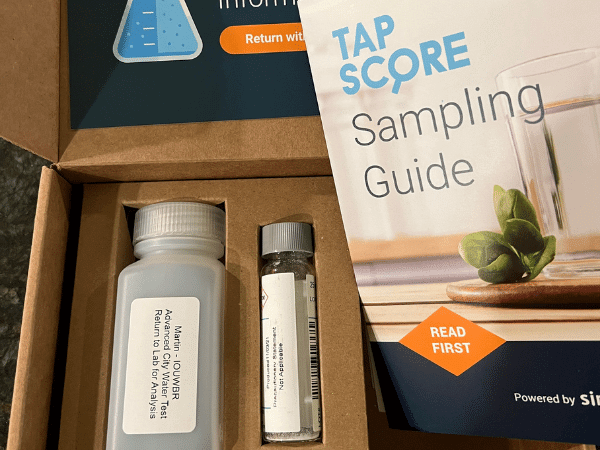
Every RO system goes through the same QWL scoring framework, blending hands-on installs, Tap Score lab testing, and certification verification:
- 🧪 Filtration Performance (45%) – Lab-verified reduction of PFAS, THMs, salts, heavy metals, and organics.
- 🚰 Flow & Efficiency (20%) – Faucet output, recovery speed, and real-world pure-to-waste ratios.
- 🔧 Install & Maintenance (10%) – Setup difficulty, footprint under the sink, and filter swap process.
- 🛠 Build Quality (10%) – Durability of parts, design footprint, and integration of smart features.
- 👅 Taste & Odor (5%) – Palatability and user feedback on “flat” vs. remineralized taste.
- 💲 Operating Cost (5%) – Filter/membrane replacement costs plus water waste.
- 📜 Certifications (5%) – Verified NSF/ANSI or WQA Gold Seal compliance.
This structure lets you compare systems apples-to-apples — not marketing vs. marketing. For example, our Tap Score testing showed:
- Waterdrop G3P800: 100% removal of chloroform and other THMs, with an 85% drop in TDS.
- AquaTru Classic: Wiped out every detectable PFAS and disinfection byproduct in lab testing.
- Cloud RO: Independent third-party testing confirmed ~99% reduction across metals, salts, and organics.
- APEC ROES-50: Certified TDS reduction, but higher wastewater and slower recovery than modern units.
⚖️ Key Buying Factors
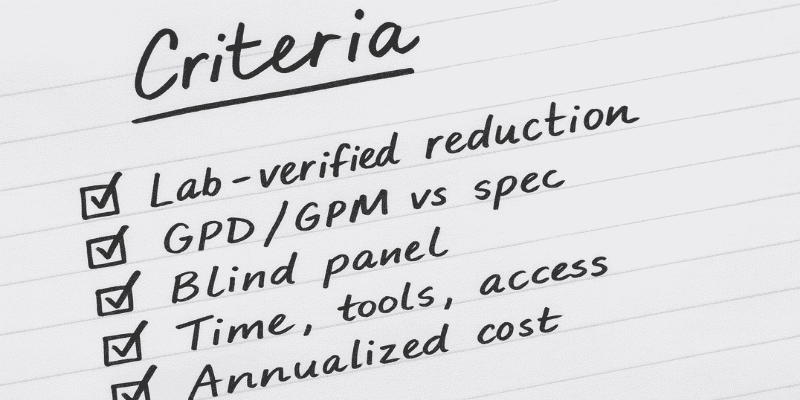
When choosing an RO system, focus less on spec-sheet buzzwords and more on how the system fits your home:
1. Contaminants That Matter: Not every system is tested for the same things. NSF/ANSI 58 or WQA Gold Seal means it’s legit for TDS reduction, but only some extend to chlorine byproducts, PFAS, or VOCs. Independent lab results give you the clearest picture.
👉 Scenario: If your city’s water report shows disinfection byproducts or PFAS, lean toward a system with broad certifications (or verified lab data). If your concern is just taste/odor, a simpler unit may be enough.
2. Efficiency & Wastewater: RO always creates some wastewater. Older tank systems may waste 4–5 gallons per gallon purified. Newer tankless or countertop designs cut that to 3:1 or even 4:1. Over years of use, that difference adds up on your bill.
👉 Scenario: A family of five running lots of drinking, cooking, and coffee water will save more long-term with a tankless design. For a single renter, efficiency matters less than upfront cost.
3. Maintenance & Costs: Filters are the real cost driver. Proprietary bundles (like some smart units) run ~$200 per year, while standard canisters can be as low as $50–80. Quick-change cartridges save time but cost more.
👉 Scenario: If you like DIY tinkering, a classic canister system is cheap to run. If you’d rather not track filter dates, app-connected systems with auto reminders may be worth the premium.
4. Space & Installation: Countertop units require no plumbing but take up counter space. Tankless under-sink models free up space and deliver fast flow but need an outlet. Tank systems eat cabinet room but are simple and proven.
👉 Scenario: Apartment dweller? A countertop model avoids drilling and landlord headaches. Large household with kids? A tankless system under the sink keeps pace without taking counter space.
5. Taste & Minerals: Straight RO water can taste flat. If you want smoother, alkaline water, look for built-in remineralization or add a cartridge. Otherwise, expect very “neutral” water.
👉 Scenario: If you’re picky about taste (coffee, tea, or just daily sipping), remineralization is worth it. If you plan to mix filtered water into smoothies or recipes, plain RO might be just fine.
💡 Pro Tip: Many homeowners forget about water pressure. Most RO units need ~50–60 PSI to run at spec. If your home is on the lower end, you may need a booster pump — especially with tank-based designs.
🌍 City vs. Well Water

RO is a powerhouse for treated city water — but it’s not always the right first step for private wells.
- City water: RO takes care of chlorine byproducts, PFAS, lead, and salts that slip through treatment plants. If your main concern is urban tap quality, RO alone is usually enough.
- Well water: Different story. Groundwater can carry iron, sediment, or even bacteria that clog or damage an RO membrane fast. In that case, RO is best used after a pre-filter (sediment, iron filter, or softener) that does the heavy lifting.
💡 Good to Know: Skipping a pre-filter on well water is the fastest way to kill an RO system — and it’s usually not covered under warranty.
🚫 Common Mistakes to Avoid
Even the best RO system won’t perform well if you overlook the basics:
- Ignoring wastewater ratios – A 4:1 system can quietly add $50–$100 a year to your water bill compared to tankless models.
- Skipping remineralization – RO water is ultra-pure but can taste flat. If flavor matters, choose a unit with built-in alkalinity or budget for an add-on cartridge.
- Forgetting water tests – City water reports don’t always tell the whole story, and well water varies house to house. A Tap Score or similar lab test ensures you buy a system that matches your contaminants.
- Assuming “NSF certified” means everything – Check which specific standards a system meets. NSF 58 covers TDS reduction, but not PFAS, chlorine byproducts, or lead unless separately listed.
- Underestimating filter upkeep – Cheaper systems save money upfront, but missed filter changes lead to bad taste, lower flow, and even membrane failure.
🧠 Pro Tip: Treat your RO like a car — filters are oil changes. Skip them, and the engine (your membrane) pays the price.
✅ Final Take
Reverse osmosis is still the gold standard for turning questionable tap water into water you trust. The choice isn’t whether it works — it’s which trade-offs fit your kitchen and budget:
- Tankless (Waterdrop G3P800): fastest flow + best efficiency
- Countertop (AquaTru): easiest setup + broadest certifications
- Tank-based (APEC/iSpring): lowest long-term cost, but high wastewater
- Hybrid smart (Cloud RO): app tracking + remineralization, higher upkeep
Bottom line: if speed matters most, go tankless. If you want plug-and-play convenience, go countertop. If cost rules, go tank. Each of our tested picks has the data to back it up — no marketing fluff, just results.. It’s just about matching the system to your kitchen, water source, and budget.
 99 people found this helpful. Was this guide helpful to you?
99 people found this helpful. Was this guide helpful to you? 
